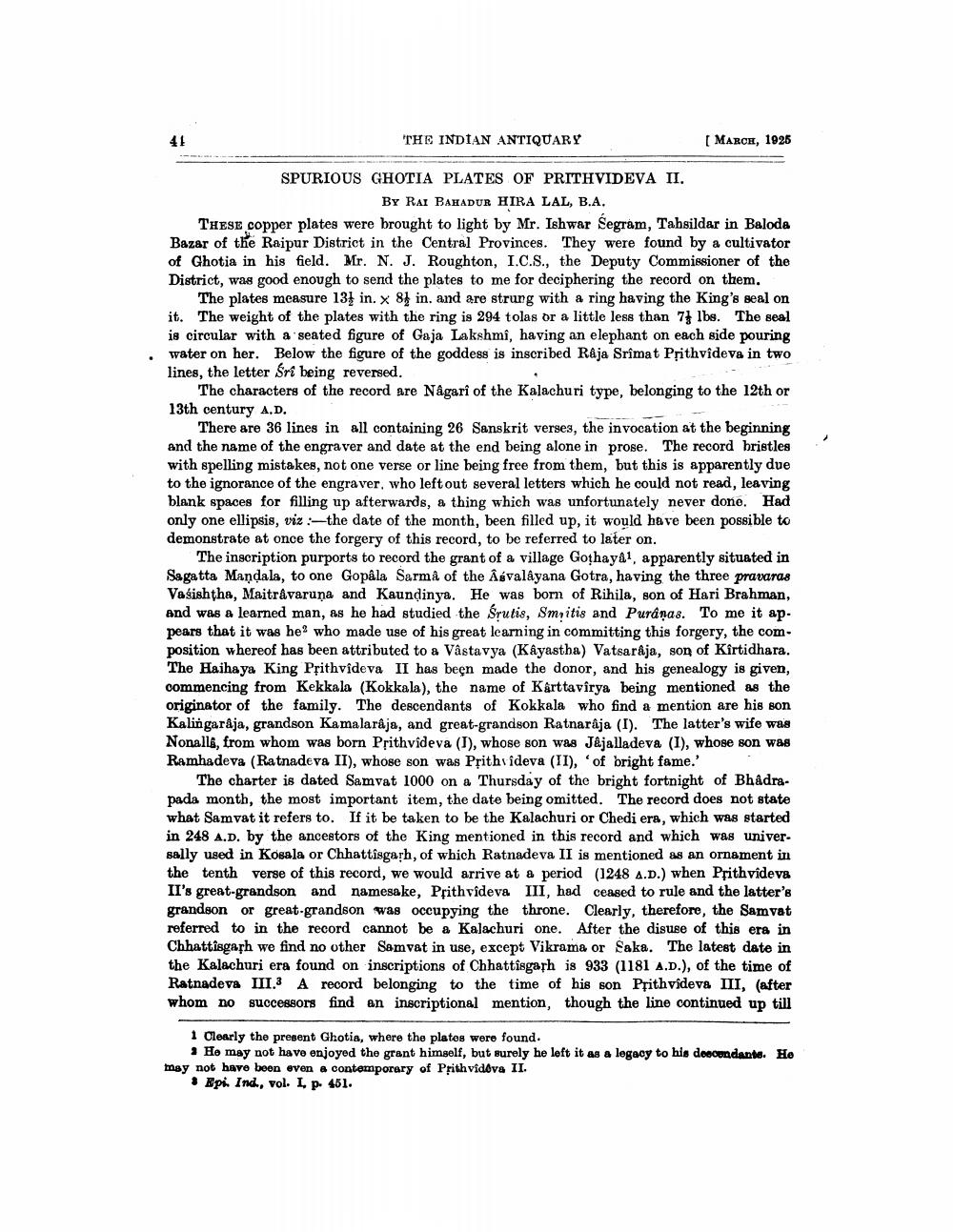________________
41
THE INDIAN ANTIQUARY
[ MARCH, 1925
SPURIOUS GHOTIA PLATES OF PRITHVIDEVA II. BY RAI BAHADUR HIRA LAL, B.A.
THESE Copper plates were brought to light by Mr. Ishwar Segram, Tahsildar in Baloda Bazar of the Raipur District in the Central Provinces. They were found by a cultivator of Ghotia in his field. Mr. N. J. Roughton, I.C.S., the Deputy Commissioner of the District, was good enough to send the plates to me for deciphering the record on them.
The plates measure 13 in. x 8 in. and are strung with a ring having the King's seal on it. The weight of the plates with the ring is 294 tolas or a little less than 7 lbs. The seal is circular with a seated figure of Gaja Lakshmi, having an elephant on each side pouring water on her. Below the figure of the goddess is inscribed Raja Srîmat Prithvîdeva in two lines, the letter Śri being reversed.
The characters of the record are Nâgarî of the Kalachuri type, belonging to the 12th or 13th century A.D.
There are 36 lines in all containing 26 Sanskrit verses, the invocation at the beginning and the name of the engraver and date at the end being alone in prose. The record bristles with spelling mistakes, not one verse or line being free from them, but this is apparently due to the ignorance of the engraver, who left out several letters which he could not read, leaving blank spaces for filling up afterwards, a thing which was unfortunately never done. Had only one ellipsis, viz:-the date of the month, been filled up, it would have been possible to demonstrate at once the forgery of this record, to be referred to later on.
The inscription purports to record the grant of a village Gothayâ1, apparently situated in Sagatta Mandala, to one Gopâla Sarmâ of the Asvalâyana Gotra, having the three pravaras Vasishtha, Maitrâvaruna and Kaunḍinya. He was born of Rihila, son of Hari Brahman, and was a learned man, as he had studied the Śrutis, Smritis and Puranas. To me it appears that it was he? who made use of his great learning in committing this forgery, the composition whereof has been attributed to a Vâstavya (Kayastha) Vatsaraja, son of Kirtidhara. The Haihaya King Prithvideva II has been made the donor, and his genealogy is given, commencing from Kekkala (Kokkala), the name of Karttavîrya being mentioned as the originator of the family. The descendants of Kokkala who find a mention are his son Kalingaraja, grandson Kamalarâja, and great-grandson Ratnarâja (I). The latter's wife was Nonallâ, from whom was born Prithvîdeva (I), whose son was Jâjalladeva (I), whose son was Ramhadeva (Ratnadeva II), whose son was Prithvideva (II), 'of bright fame.'
The charter is dated Samvat 1000 on a Thursday of the bright fortnight of Bhadrapada month, the most important item, the date being omitted. The record does not state what Samvat it refers to. If it be taken to be the Kalachuri or Chedi era, which was started in 248 A.D. by the ancestors of the King mentioned in this record and which was universally used in Kosala or Chhattisgarh, of which Ratnadeva II is mentioned as an ornament in the tenth verse of this record, we would arrive at a period (1248 A.D.) when Prithvideva II's great-grandson and namesake, Prithvideva III, had ceased to rule and the latter's grandson or great-grandson was occupying the throne. Clearly, therefore, the Samvat referred to in the record cannot be a Kalachuri one. After the disuse of this era in Chhattisgarh we find no other Samvat in use, except Vikrama or Saka. The latest date in the Kalachuri era found on inscriptions of Chhattisgarh is 933 (1181 A.D.), of the time of Ratnadeva III.3 A record belonging to the time of his son Prithvideva III, (after whom no successors find an inscriptional mention, though the line continued up till
1 Clearly the present Ghotia, where the plates were found.
* He may not have enjoyed the grant himself, but surely he left it as a legacy to his descendants. He may not have been even a contemporary of Prithvidova II.
Epi. Ind., vol. I, p. 451.




